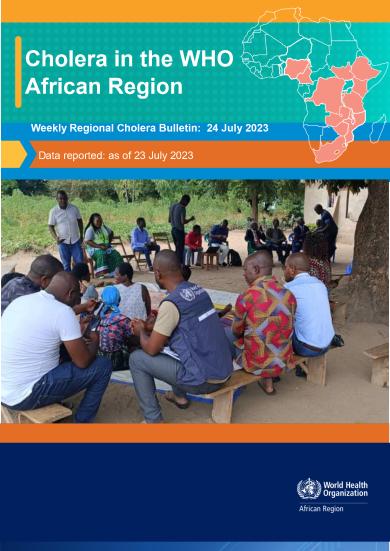
Weekly Regional Cholera Bulletin: 24 July 2023
The cholera outbreak has affected 14 countries in the WHO African Region. The climate-induced natural disasters such as cyclone and flooding in the southern African region and drought in the Horn of Africa led to increase in cases of cholera in many of the affected countries. With the rainy season commencement in the west African region there is risk of more cholera outbreaks on the horizon. The trend across the region is being closely monitored and this highlights the need for Member States to enhance readiness, heighten surveillance and institute preventive and control measures in communities and around border crossings to prevent and mitigate cross border infection.
In Epidemiologic week 29, eight countries Burundi, Cameroon, Ethiopia, Kenya, Malawi, Mozambique, Tanzania and Zimbabwe reported a total of 1 169 new cases. No new cases have been reported from South Sudan and Zambia for the past six weeks.
Since 1 January 2022, a cumulative number of 217 186 cholera cases has been reported to the WHO Regional Office for Africa (AFRO), including 4 002 deaths with a case fatality ratio (CFR) of 1.8% as of 23 July 2023 (Table 1). Malawi accounts for 27% (58 947) of the total cases and 44% (1 766) of all deaths reported, and together with Cameroon, Democratic Republic of the Congo, Mozambique, and Nigeria contribute to 84% (181 467) of the overall caseload and 87% (3 466) of cumulative deaths.
The cholera outbreaks in the African Region are occurring in the context of natural disasters such as cyclones (Mozambique, Malawi), flooding (Mozambique, Malawi), drought (Kenya and Ethiopia), conflict (Cameroon, Democratic Republic of the Congo, Nigeria, Ethiopia) and multiple disease outbreaks including Mpox, wild polio, measles, COVID-19, etc. Many countries have limited and strained resources, shortage of medical commodities, including cholera kits and Oral Cholera Vaccine (OCV). Poor sanitation and unreliable water supplies with increased cross-border movements also serve as driving factors for the outbreak across the region.